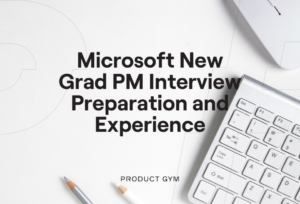The nature of hiring in product management changed to overcome the logistic limitations of Covid-19: networking became more challenging, and the virtual interview became the new norm. The pandemic may be on its way out as cities reopen across America, but it’s uncertain what business practices will actually go back to the way they were before as working remotely offers plenty of benefits.
Many companies may choose to continue with video calls for their product manager interviews, whether these are for an onsite or calls with different stakeholders. They are asking the candidates to do “onsites” and even fourth (final) rounds with CEOs, founders, and vice presidents virtually.
While a virtual interview might seem very similar to an in-person interview, it is more challenging for you to communicate with the interviewer through the webcam. To make your next virtual interview as seamless as possible, we put together our top three tips for nailing the video call interview. Keep these in mind for your next virtual interview!
1. Establish A Structure
When you are on the call, keep in mind that you can only speak one at a time. Therefore, you need to establish a structure in the virtual interview, both implicitly and explicitly.
What do we mean by “establishing a structure”? Due to the nature of the interview, it is very challenging for you to interject into the conversation. To keep the dialogue between you and the interviewer lively rather than back and forth like an interrogation, adopt some strategies.
Body Language
The best way to implicitly structure your interview is through the use of body language. Since body language in a virtual interview is very limited compared to that of an in-person interview, you must employ some level of animation to show the interviewer that you are thinking and paying attention.
Imagine the situation from the perspective of the interviewer. Would you want to talk to someone for long who just stares at you all the time? How do you know if the candidate is listening to you? Think about body expressions and facial expressions that signal the interviewer that you want to talk.
Be Explicit
Establishing a structure explicitly is more straightforward than trying it implicitly. When you begin the call, start the conversation by stating what you want to talk about. For instance, you can start with “We have 45 minutes on the call and I would like to learn more about the company and your work. And then I would be happy to talk about myself.”
Let the interviewer know what you want to talk about during that call and be very explicit about it. You can also ask them if they have a specific structure they want to follow to make the best use of their time.
Remember to Check Your Connection
One caveat we want to note is that connection issues might cause a significant disconnection between you and the interviewer. Remember that everybody is working from home right now, and therefore there is a tremendous usage of internet and video call technologies such as Zoom. You might or might not notice if you and your interviewer are experiencing a 5-6 second delay in your responses. These delays might get very awkward very quickly, so take control of the situation by telling the interviewer that you’ll be taking some notes during your conversation before the interview begins. This way, the interviewer will believe that the lag of time between questions and answers is due to your note-taking. Since your webcam can’t capture your whole desk, the interviewer won’t be able to tell when you’re taking notes or not.
Another virtual challenge to prepare for is the fact that onsite calls are back to back. So, you will not have much time for your needs (i.e., bathroom, water break). Think about how to equip yourself better for these needs when you are at home.
2. Set a Line of Sight and Stick to It
When you join a call, your line of sight is essential because that’s the only way your interviewer can tell whether you’re engaged or not. So, before you join the call, establish where you’re looking to talk to the interviewer. For example, if your line of sight is on the top left, you should continue to look in that direction throughout the call.
If your eyes start to wonder, the interviewer will think that you are not paying attention. The only reason why you want to switch your line of sight is to show that you are thinking about what the interviewer is talking about. You might want to show how interested you are by looking up all of a sudden. Remember, you are trying to show that you are processing the discussion and reacting to it.
Also, if you are typing notes, try not to look into another area and switch your line of sight. Again, it is imperative to establish to the interviewer where you are looking at throughout the interview.
3. (Virtually) Show Character
Perhaps, the greatest challenge of a video interview for you is not having the tools you might typically have to show your personality to the interviewer. The quality and the quantity of body language that you can communicate to the interviewer through video chat are minimal. Therefore you have to make the best use of it.
You have to show some sort of animation in your body to convey to the interviewer that you are doing things beyond listening. Use your hands to communicate ideas and express your thinking. Do not look into the camera like a robot. You can also smile, blink, and show some sort of facial expression. Sometimes, it’s even better to exaggerate it since you have to convey to your interviewer your level of energy, which can be challenging during a video interview. The best way to show enthusiasm is to have some sort of body expression, which, of course, is limited to the viewpoint of the tool that they are using.
Final Notes
At the end of the day, what you have to do is to communicate your personality through confidence and energy level. Think about ways of conveying this through the limited means of a video call before the “onsite”.
Although the way onsites are conducted has changed dramatically, the content of the discussion remains the same. If you are wondering about the kinds of questions you’ll be facing in an onsite interview, check our final round interview preparation guide.
Need more interview tips? We’re all about getting people jobs in product management. That means we want to equip you with the knowledge and skills you need to kickstart your dream career in product management: we’re here to support you on your job hunt.
If you want to learn more about the ins and outs of Product Manager skills and job search tactics, get in touch with us! We’re offering free career coaching sessions with our in-house team of PM Recruiter experts. We’d love to hear from you.



